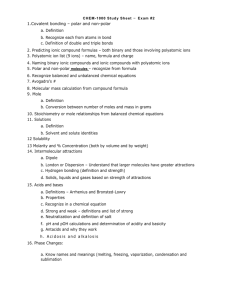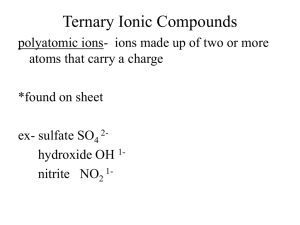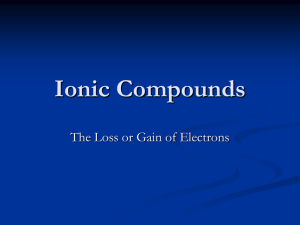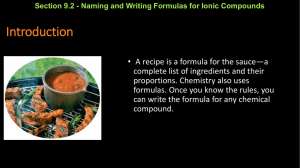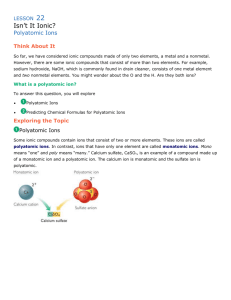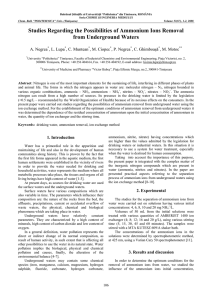Ionic Formula writing Notes
advertisement
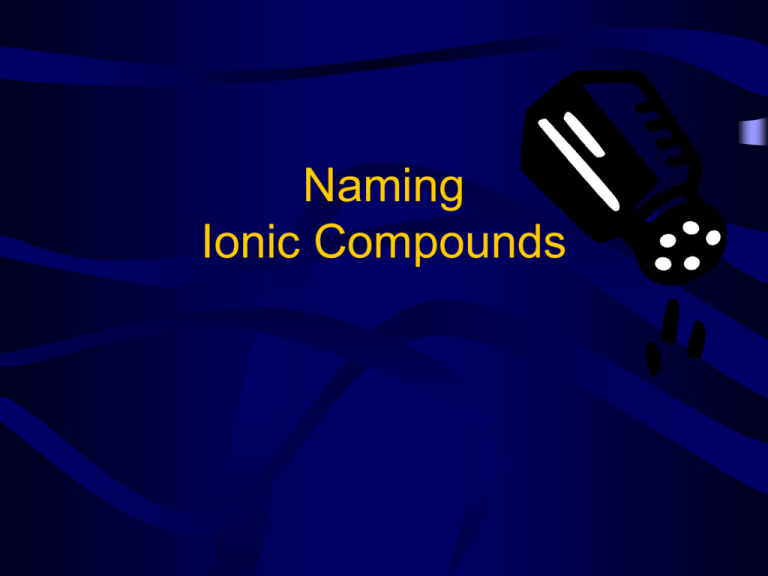
Naming Ionic Compounds Charges Elements will gain or lose electrons to have 8 valence electrons. (This is the octet rule) • • • • • • • • Group 1A +1 Group 2A +2 Group 3A +3 Group 4A N/A Group 5A -3 Group 6A -2 Group 7A -1 Group 8A STABLE • The charges of monatomic ions, or ions containing only one atom, can be determined by referring to the periodic table Ionic Compounds • ion : atom or group of atoms that has a charge • A monatomic ion is one atom with a charge • A polyatomic ion is more than one element with a charge • Example: SO42- • ionic compound: compound formed between a cation ( +) and an anion (-). – usually between a metal and a nonmetal. – also form between a polyatomic ion (like ammonium) and either a metal or nonmetal. • TRANSFER valence electrons Formation of Ionic Compounds • objects with opposite charges attract each other. • ionic bond = the strong attractive force between ions of opposite charge – Strongest type of bond!! • the overall charge of the compound will be … • ZERO! Examples of Formula Writing • Write the formula for the compound formed between calcium and nitrogen • Step One: Write the symbols and charges of the ions formed – Ca2+ N3- • Step Two: Criss Cross (Balance the charges so the total is ZERO) – You will need 3 Calcium’s and 2 Nitride’s • Step Three: Write the Formula – Use subscripts to show the number of each ion needed –Ca3N2 – If the charge is >1 than polyatomics need () More examples • Write the formula between Mg and Br • Mg+2 Br -1 • MgBr2 More examples • Write the formula for the compound formed between Ca and S • Ca+2 S-2 • CaS Polyatomic Ions • You must use parentheses when using subscripts with a polyatomic ion • Ex: Calcium nitrate • Ca +2 NO3 -1 • Ca(NO3)2 Formula writing with polyatomic Ions • Write the formula between ammonium and sulfate • NH4 +1 SO4 -2 • (NH4)2 SO4 More examples • • • • • • • Copper (II) and chlorine Silver and Nitrate Magnesium and sulfite Calcium and sulfur Potassium and oxygen Ammonium and phosphate Ammonium and chlorine • • • • • • • CuCl2 AgNO3 MgSO3 CaS K2O (NH4)3PO4 NH4Cl Naming ionic compounds • In naming ionic compounds, name the cation first, then the anion. • Cation name does not change. – If the cation can have more than one charge (mostly transition metals), use a Roman Numeral after the element name to indicate the charge • Ex. Iron (II) for Fe2+ or Iron (III) for Fe3+ • Monatomic anions: change the ending to -ide. (ex. Br -, Cl-, O2-) • Polyatomic Ions: do not change the name (ex. SO42-, CO32-, PO43- Examples • • • • • • • • NaCl MgSO4 CuSO3 K3PO4 Fe(NO3)2 Ca(ClO3)2 NH4NO2 Al(ClO)3 • • • • • • • • Sodium chloride Magnesium sulfate Copper (II) sulfite Potassium phosphate Iron (II) nitrate Calcium chlorate Ammonium nitrite Aluminum hypochlorite More examples • • • • • • • Lead (IV) Oxide Ammonium Permanganate Cobalt (II) chloride Calcium sulfide Lithium nitrate Sodium acetate Tin (II) chloride • • • • • • • PbO2 NH4MnO4 CoCl2 CaS LiNO3 NaCH3COO SnCl2

